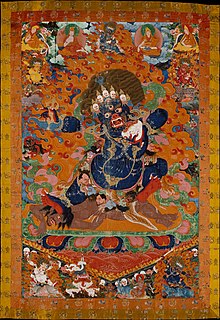ਯਮ

ਯਮ ਜਾਂ ਯਮਰਾਜ, ਇਮਰਾ ਵੀ ਕਹਿੰਦੇ ਹਨ[1] ਮੌਤ, ਦੱਖਣੀ ਦਿਸ਼ਾ ਅਤੇ ਪਤਾਲ[2] ਦਾ ਦੇਵਤਾ ਹੈ। ਇਹ ਰਿਗਵੈਦਿਕ ਹਿੰਦੂ ਦੇਵੀ ਦੇਵਤਿਆਂ ਦੇ ਮੁਢਲੇ ਪੂਰ ਨਾਲ ਸੰਬੰਧਿਤ ਹੈ। ਸੰਸਕ੍ਰਿਤ ਵਿਚ, ਉਸ ਦੇ ਨਾਮ ਦਾ ਮਤਲਬ "ਜੁੜਵਾਂ" ਨਿਕਲਦਾ ਹੈ।[3] ਪਾਰਸੀ ਧਰਮ ਗ੍ਰੰਥ ਜ਼ੇਂਦ-ਅਵੇਸਤਾ ਵਿੱਚ ਇਸਨੂੰ ਯੀਮਾ ਕਹਿੰਦੇ ਹਨ।[4] ਵਿਸ਼ਨੂੰ ਪੁਰਾਣ ਦੇ ਅਨੁਸਾਰ ਉਸ ਦੇ ਮਾਤਾ-ਪਿਤਾ, ਸੂਰਜ-ਦੇਵਤਾ Surya[5] ਅਤੇ ਵਿਸ਼ਵਕਰਮਾ ਦੀ ਧੀ ਸੰਜਨਾ ਹਨ। ਯਮ Sraddhadeva ਮਨੂ ਦਾ ਭਰਾ ਹੈ ਅਤੇ ਉਸ ਦੀ ਵੱਡੀ ਭੈਣ ਯਮੀ, ਜਿਸਦਾ ਮਤਲਬ ਹੋਰੇਸ Hayman ਵਿਲਸਨ ਅਨੁਸਾਰ ਯਮੁਨਾ ਹੈ।[6] ਹਰਿਵੰਸ਼ ਪੁਰਾਣ ਦੇ ਅਨੁਸਾਰ ਉਸ ਦਾ ਨਾਮ ਹੈ, ਦਯਾ।[7] ਸਰੀਵੰਚਿਯਮ, ਤਮਿਲਨਾਡੁ ਵਿੱਚ ਯਮ ਨੂੰ ਸਮਰਪਿਤ ਇਕ ਮੰਦਰ ਹੈ।
ਵੇਦਾਂ ਵਿੱਚ, ਯਮ ਪਹਿਲਾ ਪ੍ਰਾਣੀ ਦੱਸਿਆ ਗਿਆ ਹੈ, ਜੋ ਮਰ ਗਿਆ। ਪਹਿਲ ਦੇ ਗੁਣ ਸਦਕਾ ਉਹ ਚਲ ਵਸਿਆਂ ਦਾ ਹਾਕਮ ਬਣ ਗਿਆ, ਅਤੇ "ਪਿਤਰਾਂ ਦਾ ਪ੍ਰਭੂ" ਕਿਹਾ ਜਾਂਦਾ ਹੈ। [8]
ਪਾਲੀ ਵਿੱਚ ਥੇਰਵਾਦ ਬੁੱਧ ਧਰਮ ਪੁਸਤਕਾਂ ਵਿਚ ਜ਼ਿਕਰ ਆਉਂਦਾ ਹੈ ਕਿ ਯਮ ਸਹਿਜੇ ਸਹਿਜੇ ਤਿੱਬਤੀ ਅਤੇ ਪੂਰਬੀ ਏਸ਼ੀਆਈ ਬੁੱਧ ਧਰਮ ਦੇ ਬੋਧੀ ਮਿਥਿਹਾਸ ਵਿਚ ਧਰਮਪਾਲ ਦੇ ਤੌਰ ਤੇ ਵੱਖ-ਵੱਖ ਲਿਪੀਅੰਤਰਾਂ ਤਹਿਤ ਦਾਖਲ ਹੋ ਗਿਆ। ਇਸਨੂੰ ਧਰਮਰਾਜ ਵੀ ਕਹਿੰਦੇ ਹਨ।
ਹਿੰਦੂ ਮੱਤ[ਸੋਧੋ]

ਇਹ ਵੀ ਦੇਖੋ[ਸੋਧੋ]
ਹਵਾਲੇ[ਸੋਧੋ]
- ↑ Minahan, James B. (10 February 2014). Ethnic Groups of North, East, and Central Asia: An Encyclopedia (in English). ABC-CLIO. p. 205. ISBN 9781610690188.
Living in the high mountain valleys, the Nuristani retained their ancient culture and their religion, a form of ancient Hinduism with many customs and rituals developed locally. Certain deities were revered only by one tribe or community, but one deity was universally worshipped by all Nuristani as the Creator, the Hindu god Yama Raja, called imr'o or imra by the Nuristani tribes.
{{cite book}}: CS1 maint: unrecognized language (link) - ↑ Ancient History Encyclopedia.
- ↑ Puhvel, Jaan (1989). Comparative Mythology. Baltimore and London: Johns Hopkins University Press. pp. 285–286. ISBN 978-0801839382.
- ↑ F. Max Müller (Editor): The Zend-Avesta Part III, page 232
- ↑ Effectuation of Shani Adoration pg. 10-15.
- ↑ H.H. Wilson: The Vishnu Purana Volume 1, page 384
- ↑ Shanti Lal Nagar: Harivamsa Purana Volume 2, page 281
- ↑ Shanti Lal Nagar: Harivamsa Purana Volume 1, page 85
